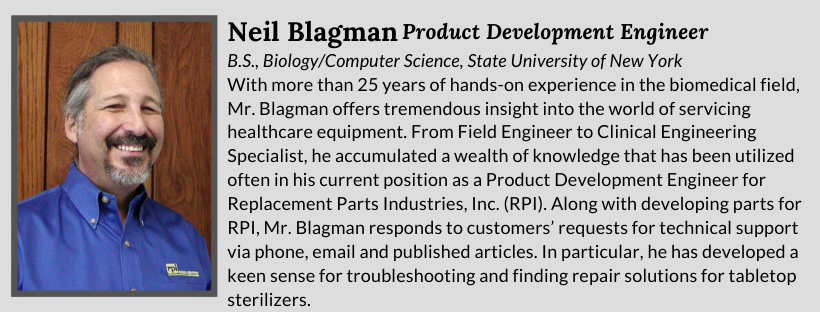
Your Key to the Sterrad NX
RPI's Product Development Engineer, Neil Blagman, shared with MedWrench service tips, planned maintenance, troubleshooting and more information on the Sterrad NX.
Wed Jul 01 2020
RPI shares tips on the Sterrad® NX™. Have a question for the expert or want to find out more after reading his tips? Fill out the form at the bottom of the page to ask Neil Blagman a question directly.
 Our sterilizer technicians are having problems with random cycle failures. What can we look for?
Our sterilizer technicians are having problems with random cycle failures. What can we look for?
The most common cause for cycle failures in hydrogen peroxide sterilizers is wet material and packs. The water remaining in wet wrappers, gauze and instrument lumen will continue to outgas during the pump down steps and lead to cycle failures.
Part of the process of preparing the hydrogen peroxide is concentrating it, where does the extracted water go?
The production of concentrated hydrogen peroxide does generate some water that has to be removed from the system before the delivery of the remaining concentrate. Much of this water (and, unfortunately, some of the peroxide) becomes emulsified within the pump oil. This is why Sterrad and RPI recommend six-month oil changes during the planned maintenance as this emulsification can lead to early vacuum pump failures and why we recommend handling all used oil from the Sterrad peroxide sterilizers as hazardous waste.
 Can you share some installation advice regarding the relocation of a 100NX to a different facility?
Can you share some installation advice regarding the relocation of a 100NX to a different facility?
A big tip we learned in our shop is to check the phase orientation of the incoming 220 VAC 3-phase line. The point where this becomes important is when vacuum pump is run for the first time. We learned the hard way to disconnect the pump from the vacuum chamber before running the pump for the first time. If the incoming phases are reversed the pump will run backwards and spray the entire inside of the chamber with vacuum pump oil – what a mess! If this happens, just reverse two of the phase wires within the power plug and the pump will run in the correct rotation.
When running the leak back test, I seem to be having some variability in the results. Why does this happen?
The leak back test can be directly affected by humidity that may be within the chamber or the vaporizer/condenser assembly. Try to start the testing process by pumping the chamber down below 100 mTorr for up to 20 minutes to completely dry the system before looking at the leak rate.
When testing the system, I tried turning on the vacuum pump and my main circuit breaker popped and the system shut down. What happened?
happened?
When you tried turning on the vacuum pump, the chamber was already at vacuum and the pump draw overloaded the breaker. Remember that you only want to start running the vacuum pump when the chamber is at room pressure – if you need to release the vacuum in the chamber, but cannot use the computer controls, then consider loosening one of the removable plugs located on the chamber pressure control assembly.
Learn more about RPI, here.

